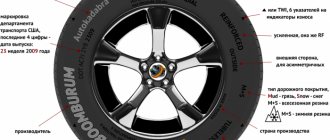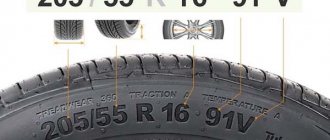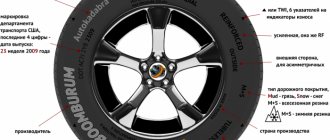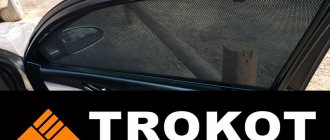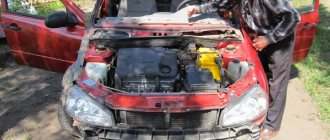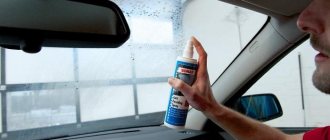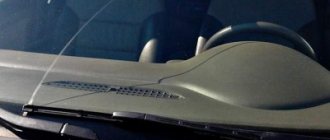03/19/2021 Today there are two types of glass for cars and five types of markings for products. Today, approximately two dozen manufacturers around the world produce auto glass.
On auto glass in the corner part at the top or bottom you can find a standard marking that will tell you about the type of glass and will allow you to determine the year of manufacture and manufacturer of the product. In addition, from the markings you can find out what actions were carried out with the car after it was stolen (if there are anti-theft markings). In other words, markings can warn and protect the car owner.
To decipher the designation on the glass, you should immediately understand what types of auto glass exist.
Let's check the car before buying!
Auto-selection
Type of auto glass
Automotive glass is ranked depending on the production material and has significant differences for the car owner in strength indicators and more.
Triplex
Glass produced using triplex technology includes several layers. Traditionally, these are two layers bonded together with a polymer film. Traditionally, such automobile glass is installed as a windshield/windshield, rarely as side or panoramic glass. On the surface of such a product it says Laminated
,
Lamisafe
, which means multi-layered.
Due to the elastic organic component, triplex is practically immune to mechanical stress and has a very high strength index. The standard thickness of the product is 5-7 mm, reinforced products are produced with a thickness of 8-17 mm.
When broken, the glass does not break into fragments, the polymer film holds them - the driver and those sitting in the car will not be harmed.
Among other positive properties of triplex:
- high degree of noise reduction;
- resistance to thermal influence;
- possibility of changing shade;
- environmental friendliness of materials.
Among the disadvantages of triplex, one can fairly note the heavy weight, complexity of the production process and relatively high cost.
Stalinite
This product is used as rear windows, door windows and hatches on top. “T” is applied to its surface
and the inscription
Tempered
,
Temperlite
,
Therlite
, which translates as tempered.
In Russia, this type of auto glass is designated by the letter Z and is installed on the Classic.
Stalinite is cheaper than triplex, however, it is not as durable. When broken, glass crumbles into small fragments with blunt edges. Motorists are not advised to use stalinite as a windshield: in the event of an accident, the fragments can harm the driver and those sitting in the cabin.
What is automotive glazing?
With the development of technology, vehicle speeds have also increased, and, consequently, the requirements for the quality of visibility and the ability to see the space around the vehicle while driving have also increased significantly.
Automotive glass
Automotive glass is a body element that is designed to provide the required level of visibility and perform a protective function. The glass protects the driver and passengers from headwinds, dust and dirt, precipitation and stones flying off from under the wheels of other moving cars.
The main requirements for auto glass are:
- Safety.
- Strength.
- Reliability.
- Sufficient service life of the product.
Manufacturers
Today there are about twenty manufacturers of automobile glass. Conventionally, manufacturers can be divided into three classes. The most famous of them:
- Manufacturers of premium products: Pilkington (UK), Saint Gobain Sekurit (France), AGC (Japan), PPG (USA).
- Manufacturers of business class glass: JAAN (Poland), Guardian (USA), Shatterprufe (South Africa).
- Companies engaged in the production of economy class glass: XYG (China), CSG (China), FYG (China), Starglass (Spain), Tamglass (Finland), etc.
Communities › Mitsubishi Lancer Club › Blog › How to determine the year of manufacture by looking at the glass?
Hello everyone! I think that many will be interested in knowing. How to determine and what do the symbols on the glass mean? Usually you can see the year of manufacture on the vases. But what’s here?
Comments 24
I'll join. By the code on the glass you can only find out... the year of manufacture of the glass
The car's release date can be read by the code on the label under the hood. The glass is not necessarily produced in the same year as the car's release. It happens that the parties of the end of the year are actually placed under the future already.
It turns out that the production date of the glass does not always coincide with the production date of the car. Last year I saw this on a friend’s new Qashqai
There is no production date on our original glass, so don’t solve the puzzles.
Yes, the month is the number of dots and the number on the glass is the year of manufacture but not on this glass
So we seem to be talking about this glass, I have the same markings, no dots, no years:(((
I don't know, when I was in Vladik I drank Asahi beer, excellent beer, but I haven't heard about glass. so sorry))
but I thought it was a good company like “About the company
The brand of beer was like that, I don’t argue, I even brought it with me, in aluminum bottles, not in cans but in buns for 0.33
it’s clear who’s off to the forest, who’s off to pick mushrooms...
There is no production date on our original glass, so don’t solve the puzzles.
Source
Marking
Original car windows are distinguished by factory markings or rejuvenation. If you learn to read the designation, you can not only avoid running into a fake, but also find out where the product was certified, its release date and other data of interest to the motorist.
The marking is located in the corner of the product (top or bottom). It consists of several components:
- manufacturer/trademark name;
- type of glass (material);
- compliance of the product with the European quality standard and the code of the country in which the certification was carried out (letter E with a numeric code on top).
We professionally check the car before purchasing
Free consultation
Standards
Let's look at several marking standards in more detail and explain them using specific examples.
American
The American type of marking is subject to the FMVSS 205
. All products transferred to car factory conveyors are marked with certain information that guarantees the safety of the part.
The monogram-shaped marking has the interesting name beetle.
The US standard has the symbols
DOT
,
M
and
AS
. The number after the DOT is a certificate from the manufacturer confirming that the product complies with the requirements of the American Department of Transportation.
Having looked at the PPG glass marking in the example below and checking code 18, we can say that the product belongs to PPG and was manufactured in Pittsburgh (USA).
European
In Europe, there are safety standards that apply to cars sold in EU countries. Since several countries have legislation in Europe, it was decided to create and adopt a single standard, ECE R43
, signed by all EU members.
On products with European markings, the letter “ E
” is located in the monogram.
Some elements of auto glass sold and installed in America have European type markings and are written on the surface AS
.
Using the example of glass markings below, we can say that the product is manufactured under the Pilkington brand. E1
certification in Germany .
Product manufacturer code 682
(ST HELENS WA, ENGLAND).
Glass markings for Chinese and Japanese cars
Chinese glass
In the markings of glass manufacturers from China and Japan, everything is read according to
similar principle. From the glass markings of the Chinese manufacturer FY, which owns two pairs of factories for the production of auto glass, we see that this is a multilayer product. The glass was certified in the Netherlands.
In this case, the letters CCC
in a circle.
This means that the car is delivered to Europe. In other cases, the marking contains CCC E000199/E000039
.
Japanese glass
Here is an example of glass marking from a large global glass manufacturing concern, Asahi Glass Company (Japan). All products prepared in this country are encrypted with code 43.
This glass bears the AGC Automotive brand. Asahi Glass Company also includes Asahi, Lamisafe, AP Tech. Splintex, Temperlite, Asahimas, BOR.
In addition, the sticker contains the following symbols:
- E6 43R
mark officially approved; - DOT 24
manufacturer code - M203
code indicating the type of material, including thickness and color; - AS1
compliance with the quality standard accepted in America; - . . 3
date of manufacture (the dots are the month, the number is the year of production) - 2601 Euro
car
Russian glass
The Russian type of glass marking is subject to GOST 5727-88
, operating in the Russian Federation. VAZ glass marking (see example below) includes the following elements:
- WL
laminated automotive glass (windscreen); - TINTED
heat absorbing; - E2 43R 000 5418
signs officially approved; - ARB
(in a diamond) is a sign of the Bor Glass Factory for the Renault-Nissan-AvtoVAZ alliance. - …… 8
Date of issue.
How to find out the year of manufacture of a car
Before concluding a purchase and sale agreement for a used car, it is important to find out the production date of the car. This procedure will help to identify attempts at deception on the part of the seller of the vehicle and draw a conclusion about the rationality of the intended purchase. Today “Autocode” will tell you about the methods by which you can determine when a car was produced.
Decoding glass markings
Summarizing and supplementing the information given above, we will provide a complete explanation of the labeling of automobile glass with explanations:
1. Trademark (trademark)
Indicates that the product belongs to a specific manufacturer - AGC AUTOMOTIVE, Pilkington.
2. Extended type of auto glass
Slanted Roman numerals from I to VI are applied to the surfaces of the corresponding types of glass:
- I reinforced wind ones;
- II multi-layer windscreens;
- III triplex processed;
- IVplastic;
- V non-wind with a capacity percentage less than 70;
- VI two-layer with the same coefficient.
3. Country code (E)
This refers to the country in which the glass was certified. The product may contain combinations of letters and numbers from E1 - Germany to E43 - Japan.
| Code | A country |
| E1 | Germany |
| E2 | France |
| E3 | Italy |
| E4 | Netherlands |
| E5 | Sweden |
| E6 | Belgium |
| E7 | Hungary |
| E8 | Czech |
| E9 | Spain |
| E10 | Serbia |
| E11 | England |
| E12 | Austria |
| E13 | Luxembourg |
| E14 | Switzerland |
| E16 | Norway |
| E17 | Finland |
| E18 | Denmark |
| E19 | Romania |
| E20 | Poland |
| E21 | Portugal |
| E22 | Russia |
| E23 | Greece |
| E24 | Ireland |
| E25 | Croatia |
| E26 | Slovenia |
| E27 | Slovakia |
| E28 | Belarus |
| E29 | Estonia |
| E31 | Bosnia and Herzegovina |
| E32 | Latvia |
| E37 | Türkiye |
| E42 | European Community |
| E43 | Japan |
4. Designation of the material number (M)
5.
Material code
, which determines the type of product, includes the shade and its thickness. Date of production of auto glass
This information can be given in two forms:
- Through a fraction indicating the month and year of manufacture, for example, 5/20 May 2020.
- A combination of numbers and dots. The number and dots display the year, the sum of the dots before the digital designation, the month of manufacture, the sum of the dots after the digital designation, the month of manufacture + 6.
6.The product has been tested for strength and throughput
- AS1. The product can be secured anywhere in the vehicle.
- AS2. Cannot be used as a windshield (failed penetration test).
- AS3. The product cannot be used on a car as a windshield or side glass. Applicable to tinted glass.
7. DOT Code or Manufacturer Code
The numbered code indicates the actual manufacturer of the glass.
This code must be displayed on all products without exception. 8. Auto glass type
- Laminated Lamisafe of two or more words with film
- Tempered, Temperlite, Therlite hardened
9.
Compliance with safety standard
CCC E000199/E00039 (China)
10.
Compliant with safety standard
ECE R43 (43R-001532) (Europe)
Date of manufacture
Unfortunately, there is no standard rule according to which this useful information would be indicated. However, there are three methods that factories use when indicating the date and month of production of a product on the label:
- In the first case, two numbers are indicated, separated by an oblique stick or dot. Everything here is extremely simple. The first two characters indicate the year of production, and the second - the month. Accordingly, the glass in the first image appeared in January 2005.
- The situation is more complicated if the numbers form a kind of pyramid and can be located at different distances from each other (second picture). In this case, the symbol located at the very top indicates the year of production. Accordingly, this glass was manufactured either in 2008 or 1998. To make a more precise determination, you can find information about the year the production of a specific generation of cars began. It always changes every 10 years, so determining the exact year is not difficult. The numbers in the second row of the “pyramid” (there may be several of them) add up to each other. In our case, it is simply 8. It indicates the month of glass production - August. The third line is responsible for the day of the month. We add the numbers 20+1+8 and get 28. This means that the glass was produced on August 28, 2008, or possibly 1998.
- The third picture has dots and the number 1. This indicates that the glass was produced in either 2001 or 1991. If you count the dots, you get 3. This means that the month of manufacture is March. If the dots were after the number 1, then you would need to count them and add 6, then you would get September.
We've sorted out the basic and most common marking symbols. But there are often additional incomprehensible symbols on the glass.
Badges on glass. Additional designations
Additional images may be drawn on the car glass, the decoding of which also does not hurt to know:
"Acoustic" or ear-shaped pictogram. Indicates a product that absorbs sound.
Lamination of side windows: guarantees safety.
Side glass lamination: high impact resistance
The product has built-in glass heating.
The combination of letters “IR” means an athermal product.
Thermometer, needle, without the letters UU – solar reflective glass.
Thermometer, needle, without the letters UU – solar reflective glass.
Mirror image with arrow - product with anti-reflective coating
The image of droplets is glass that repels water.
Built-in antenna sign.
Recommendations
When choosing a car, pay attention to the production date of the glass and different markings on one or more may indicate serious problems, which on your part should necessarily lead to a more thorough further inspection of the car.
But the most interesting thing is that there are unscrupulous sellers, mostly, of course, outbid sellers who buy the chips and then restore them, remove them, that is, simply erase the date markings.
When trying to obtain information, I recommend inspecting all elements that may contain production date information, except for glass, such as seat belts. Good luck to everyone on the roads!
Source
Anti-theft marks
There is also anti-theft marking. Its presence is determined by the VIN number of the car - this is a special identification code that is also located on the body and engine. It is displayed in digital versions:
- The code is applied in the form of dots or the characters are written out completely.
- Only the last digits are indicated.
- It is etched onto the glass and it takes on a matte finish.
Special marks indicate car windows and mirrors. They are also written on the headlights and taillights of vehicles. For application, a special stencil etching method with a special paste containing acid is used. Sometimes they use sandblasting, spraying coarse quartz sand under pressure onto the glass. Anti-theft marking provides its advantages:
- If a car is stolen, then in order to sell it, the thief will try to erase the inscription of the year of manufacture so that he will not be identified. It is almost impossible to officially sell such a car.
- Marking allows you to quickly detect glass, headlights, and windshields that were stolen through dismantling points and service centers.
- The cost of anti-theft marking is low when compared with the damage caused by car theft.
